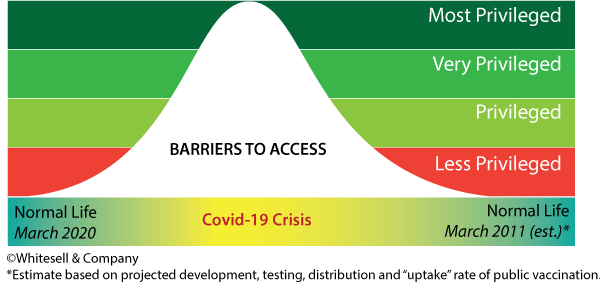IX.01.2020 - The Future of Community Engagement
The Covid-19 pandemic has changed almost every aspect of society from the way we work, play, celebrate, and mourn. The pandemic has also identified many foundational cracks within our systems and has exposed numerous unjust, unsustainable, and inequitable structures. The pandemic has revealed an opportunity to make corrections to systems, approaches, and decision-making that we once took for granted.
I attended my first memorial for a friend who died at her home in Mexico. Claire Carrison coached executives around the world for over 40 years, and she inspired people to live — not just exist. Zoom was able to bring dozens of family and friends together, share memories, and listen to a Southern gospel group send Claire off in style. That celebration of life would have been difficult to execute without technology, and, other than missing the hugs, it was a remarkable event.
In the context of municipalities, this global pandemic has made us reassess which city-building practices are working, and which ones are not, beginning with community engagement.
Community engagement is defined as a process that brings members of a neighbourhood, community, or city together to spark more substantial involvement in city-building practices.[1] It is a strategy to form and strengthen local bonds, bring together all members of society, and promote civic leadership and involvement. It is a process of gathering data to inform decision-makers about what their communities envision, what is missing, and to deliver services based on priorities, growth, and sustainability. This is the DNA of a community strategic plan.
As recently as February 2020, most community engagement processes related to developing strategic plans that involved mostly in-person interaction to bring the local community together. This took the form of interviews, town halls, focus groups, and community consultations. But the COVID-19 crisis has caused us to consider alternate engagement tactics and tools that may, in fact, expand the reach, effectiveness, and long-term impact of the typical community engagement process.
Whitesell & Company has included a suite of electronic and online tools, surveys and conversations through multiple platforms and tools to expand the reach of our community engagement approach. We can even use hybrid techniques such as providing the option of using telephones for residents to call into a town hall meeting that is actually enabled by high-speed internet. These tools are grounded in a strategic approach that provide additional, non-contact reach while identifying the type of engagement technique that will work best in the context of any municipality. By reaching a wider range of diverse people, we can gather valid data and illuminate clear directions that will inform the community strategic plan, service delivery review or organizational review.
This approach is more than a band-aid solution to conduct community engagement during these unpredictable times. It may prove to be a preferred and better way to be inclusive, expand engagement, and improve the reliability of the data that we gather.
Simply getting online is a privilege and everyone in the community may not have access on equal terms. Even when access to high-speed internet is available, there may be an affordability issue for some households, and they may be pushed to the sidelines of community engagement and decision-making. Another barrier is encountered by people who are digitally illiterate. Figure 1 illustrates the barriers to participation during community engagement initiatives.

So, in practice and without enhanced tools for community engagement, those with economic privilege and digital literacy will have their voices heard while many others will not. People who are left out of the community engagement process are the critical pieces of the puzzle. Missing these data will result in an incomplete picture. It is our job to seek out these underlying narratives, find methods to connect and help create strategies to build the communities of the future with input from all stakeholders.
The novel coronavirus must not stop municipalities from moving forward. Technological tools such as simulcasting or virtual engagements through webinars, live streams, or virtual Q&A periods with text support, video, and live polling are other techniques that can be utilized to their fullest advantage for community engagement opportunities. Imagine being able to participate and engage in a Council deputation from the comfort of your own bed — or not! Another channel for community engagement will be to consider social media platforms where we can gather data or target specific groups within these platforms. Not all social media platforms have equal audience representation.[2]
Civic plans, strategies, and reviews are developed from the ground up where people live and where communities are created. It is through these technology-enhanced forms of community engagement that we can build municipalities in a just and equitable manner. It is our job to listen to, adhere to, and take action in what the residents, businesses, and visitors of a community are voicing and work to provide an assortment of proven, accessible engagement options. That is how democracy works. It took a crisis that temporarily isolated the people in our communities to develop better ways to bring us back together.
[1] Camila Uriona. 880cities.org
[2]  Ontario Together is an example of community-led leadership. The Province of Ontario has created a platform that allows for civic outreach while also seeking advice and solutions from community members to combat COVID-19.
Ontario Together is an example of community-led leadership. The Province of Ontario has created a platform that allows for civic outreach while also seeking advice and solutions from community members to combat COVID-19.
